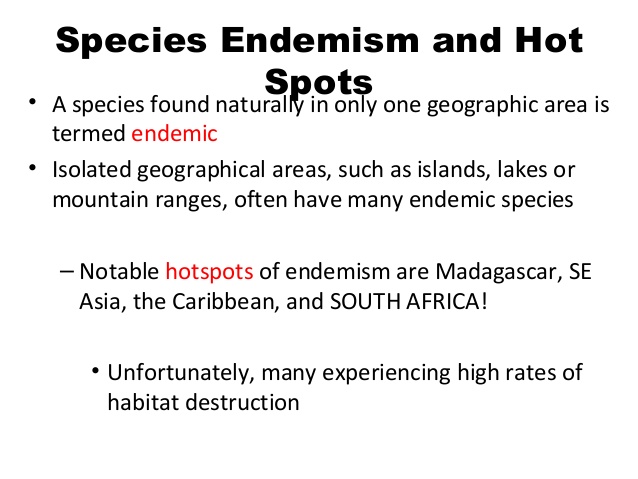Endemism – Botany Notes – For W.B.C.S. Examination.
এন্ডেমিজম – উদ্ভিদ বিদ্যা নোট – WBCS পরীক্ষা।
Endemism is the condition of being endemic, or restricted in geographical distribution to an area or region. The area or region can vary in size, and is defined or identified in different ways. Endemism is an ecological classification in that it describes the range or distribution of a species, or group of species. For instance, entire families of different species of birds are endemic to the island of Madagascar. The term endemism can applied to many things, including diseases and natural phenomenon.Continue Reading Endemism – Botany Notes – For W.B.C.S. Examination.
Endemism in these cases refers to the “normal” or standard level of some measured observation within a specific geographic region or area.
Endemism is not to be confused with indigenous, a term which refers to the origins of a species. Indigenous refers to where a group originated. A species can be both endemic and indigenous to an area. However, some species thrive and exceed the bounds of their original indigenous location. This means that the species is no longer endemic, but is still indigenous to the original area. Once a species has reached a wide-spread, global distribution it is said to be cosmopolitan. Animals like whales, once indigenous to a specific mainland in the form of their 4-legged ancestors, are now cosmopolitan in distribution.
Endemic Species
An endemic species is a species which is restricted geographically to a particular area. Endemism in a species can arise through a species going extinct in other regions. This is called paleoendemism. Alternatively, new species are always endemic to the region in which they first appear. This is called neoendemism. Both forms of endemism are discussed in more detail under the heading “Types of Endemism”, below.
Endemic species, regardless of how they came to be restricted to a particular area, experience the same threats to their existence. The smaller the region, the more dire the threat toward the survival of the species. Any action that reduces the size of the land, or divides it in any way can significantly affect the normal patterns of the endemic species. While endemism and being endangered or threatened are different things, being endemic to a small area is often a warning sign that a species may become threatened or endangered.
This is not always the case, as many globally distributed species are also considered threatened or endangered. In recent years, many sharks have joined the list. While they are distributed throughout many of the ocean’s waters, the harvesting of shark fins for soup has decimated their populations globally. Endemism sometimes protects species from being exploited globally, simply because of the fact that the species only exists in a small area. This can even make the species easier to protect, because the land can be placed under a conservation easement to restrict the construction and human impact on the land.
Endemic Disease
Scientists studying epidemiology, or disease outbreaks, have a similar definition of endemism. An endemic disease is a disease seen at consistent levels in specific location. For instance, endemic relapsing fever is a disease seen in Europe and in North America. The disease is not seen in any sort of observable amounts in other parts of the world. Other diseases, which are new to an area or are spiking in their prevalence, are known as epidemic diseases.
There are many endemic diseases, and their endemism has roots in the species and vectors which promote these diseases. In the case of relapsing fever, a vector carries the bacterium of the Borrelia species. There are several vectors which can carry these bacteria, mostly including ticks and lice. The species of ticks and lice which carry these bacteria are endemic to the Northern Hemisphere. Borrelia bacteria are also responsible for Lyme disease, a disease endemic to the Northern Hemisphere. A map of Lyme disease is shown below, and corresponds to the endemism seen in tick and lice species.While Lyme disease and relapsing fever are endemic to these areas, they are not endemic to say, Australia. If there were even a few cases of Lyme disease in Australia, the disease would be considered epidemic, because the normal level of Lyme disease in Australia is zero.
For Guidance of WBCS (Exe.) Etc. Preliminary , Main Exam and Interview, Study Mat, Mock Test, Guided by WBCS Gr A Officers , Online and Classroom, Call 9674493673, or mail us at – mailus@wbcsmadeeasy.in
Visit our you tube channel WBCSMadeEasy™ You tube Channel
Please subscribe here to get all future updates on this post/page/category/website



 Toll Free 1800 572 9282
Toll Free 1800 572 9282  mailus@wbcsmadeeasy.in
mailus@wbcsmadeeasy.in


















































































































